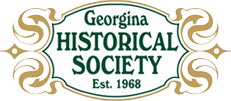Click to Download the PDF
Download the Word Doc
President’s Message
Please remember to renew your membership for 2022; the GHS greatly appreciates your support. We hope to be able start off 2022 with a return to our monthly general meetings. Our first meeting will be the popular “Bring and Brag” theme, it is time to start thinking of some photo, old tool, or artifact that you can bring to share.
Please remember we need your stories and pictures to help make the newsletter a success.
Looking forward to seeing everyone at the 2021 GHS Annual Meeting on November 18 at 7:pm at De La Salle Hall.
Take Care! Stay safe!
~ Tom Glover
WW1 and WW2 – Remembering ~ by Tom Glover
On Remembrance Day our one room school house would hold a special afternoon program to honour the soldiers who served in WW1 and WW2. A local veteran, Bert Stephens would always take time from his busy farm schedule to come and distribute poppies. We would bring our nickels, dimes and pennies to donate to the Legion Poppy Fund. Our roll call for the meeting would be a name of a soldier who had served in one of the wars. This is where I first heard the names of the local men and women who served in WW1 and WW2.
My parents told me of the good and the bad results of the war on our family.
While serving in the army, my mother’s younger brother Tommy met a girl, Isabel from BC and they fell in love and were married. Her sister Ruth’s fiancé, Willard was killed in a plane crash while training a novice pilot. My father’s cousin, Joe died on the beaches of Dieppe, he was just one of the many casualties of that ill-fated action. His cousin Frank, boxing champion of the Canadian Armed Forces was awarded a medal for his valiant actions as a tank commander on the Gothic Line. Growing up I learned more about neighbours who served in the war. Men like Cliff, a young man who died fighting for his country and who my mother when asked, remembered him with a smile and the response “He liked to dance with me”; Jim, a tail gunner who told me of flying many bombing missions and being so uptight he would be sick to his stomach before and upon returning from the mission; John, a spitfire pilot; who would believe this gentle, good natured man piloted a fighter plane and yet there in the farm kitchen hung a picture of a fierce young pilot and his plane. The Bosworth, Stephens, Mahoney, Barker, Martin, Pollock families to name just a few all saw young family members off to war. Unfortunately, not all returned. The war touched many lives.
I think even more families had been affected by WW1, “The War to End All Wars”.
Patriotic duty and the desire for adventure led many young men to join up.
My family are good examples of how the war touched the community.
Typical of the young men, my grandfather’s brother, an engineer, had been surveying in northern BC when the war began. On returning to Vancouver he was shocked to hear that Canada had been at war for 6 months. He was afraid the war would be over before he had a chance to serve on the front lines and signed up as soon as he could.
Serving with the Third Tunneling Corps, in France, he survived the war only to die in a London hospital from appendicitis while awaiting orders to disembark for home.
As well as his brother, Grandfather Glover had six cousins who served in WW1.
They left their families and their jobs as farmers, masons, seeds men and river drivers to serve King and Country. One whose son had joined up in the spring of 1916 and at 54 being too old himself to be accepted into the forces lied about his age and joined in the summer of the same year The son, George brought home an English bride and a baby when he returned from the war. The father was not so fortunate, trench warfare took a heavy toll on his body and he returned to his home in Canada in ill health and passed a way soon after. A Military Medal was brought home to Ravenshoe by cousin Les;
a medal received for “good work on the line” at Villes Bretoneux in March 1918.
He placed it in a drawer and never spoke about the medal or the war.
The impact of the war was similar to other families in the Ravenshoe community.
When a young man was about to leave for overseas family, friends and neighbours would gather to bid him farewell. There would be food, entertainment and speeches to honour the brave recruit. The young man would be presented with a bible as a token of friendship and a reminder of his duty to God and fellow man and with wishes for a safe return.
Aunt Flo kept a scrapbook throughout the wars duration. Clippings of events from the newspapers, poems and stories from the front lines, postcards and notes from relatives, all found their way into her scrapbook. An original clipping of “Flanders Fields” by McCrae was one special entry and other poems were copied by hand because they meant so much to her. Among her last entries was a copy of the order to cease hostilities published in the Toronto Star and her Brother Frank’s obituary from the Newmarket Era, April 1919.
A family ready to celebrate his home coming, now were to mourn his death; a cruel blow from the hand of fate. The war was hard for the soldiers on the front lines but just as difficult for their families at home awaiting their safe return.
I learned an interesting lesson about life growing up in the small, rural, post war community of Ravenshoe. Among the neighbours and family who fought in the war or lost family members in the conflict were new Canadians of German, Italian, Polish and Dutch descent, who also fought for their countries in the war. They all lived side by side in harmony and no one seemed to hold grudges for the past conflicts.
They helped each other with the threshing, loaned machinery and were always ready to lend a helping hand in emergencies. Children attended school, played together and became friends without any thought of nationality. My school mates and I learned at a young age that we were all the same, no matter what our race, religion or nationality. Canada! A welcoming home to all…a fact that we would do well to remember today.
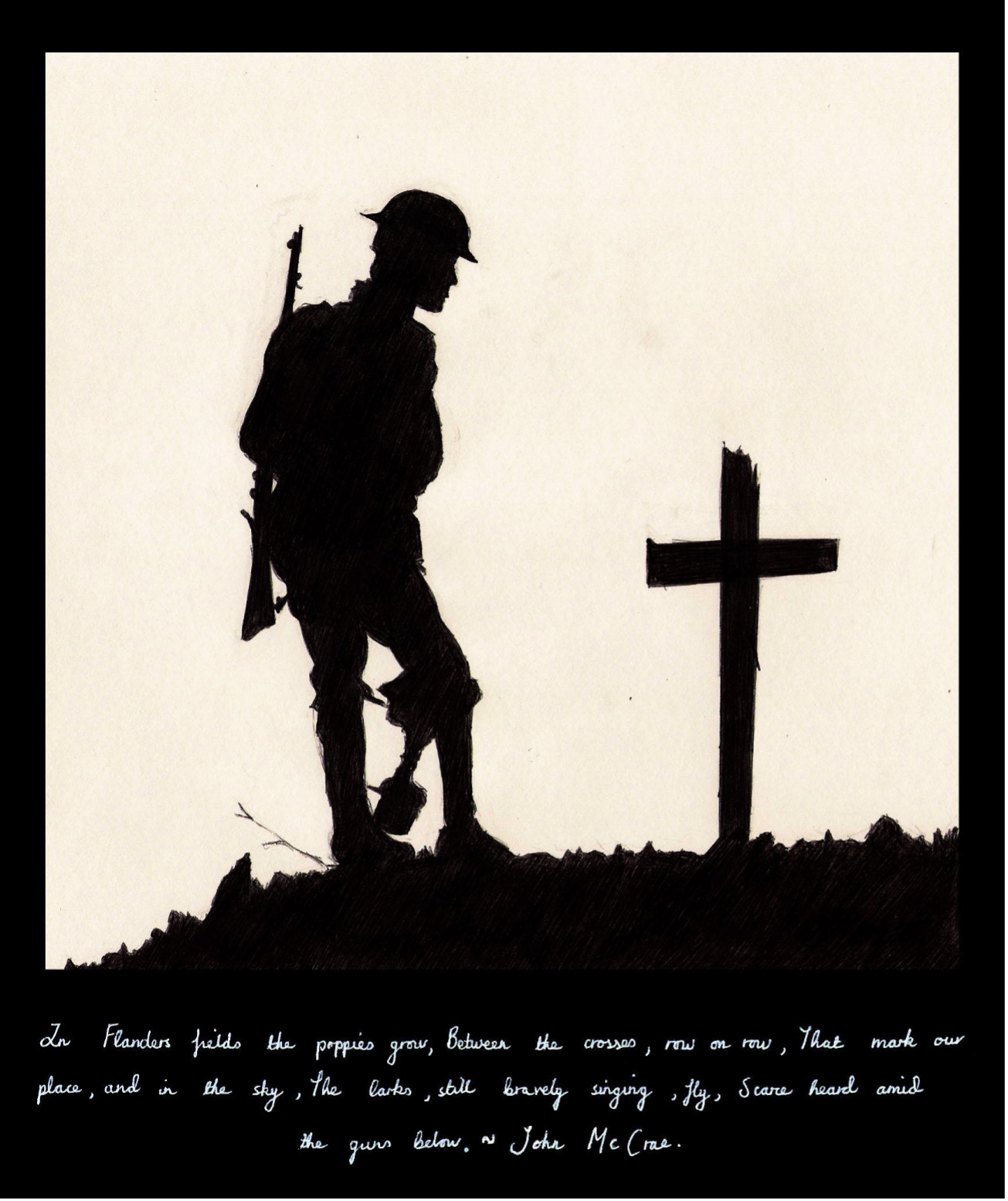
The following story was retrieved from a blog at https://joebeernink.com/2012/11/11/a-remembrance-day-short-story/ …and in his own words, the author Joe Beernink says, “While in high school, I wrote a short story called Saluting a Memory. It’s not the best writing I’ve ever done, but I have kept it around, and I’m not ashamed to show it to you now (though I did clean it up a bit for grammar, spelling and a few poorly worded sentences). I won second place with this story back in 1988 in the Lambton County Royal Canadian Legion Writing Contest, which I guess was my first ever contest win.” Editor’s note.
Saluting a Memory ~ By Joe Beernink
He sat on the edge of his bed, ready for the familiar crack of joints that had accompanied the first movements of the morning for the past decade. He rose, wavered, and grasped the chair beside the bed. He felt the stiff, heavily starched collar of the blazer someone had set there for him. He glanced down at the dull, dark green uniform jacket he remembered so well. His fingers worked their way along the collar, with the embroidered insignias and the small, brass buttons. He tried to remember why it was out. What was the occasion? The number eleven flashed in his mind; “The eleventh day of the eleventh month, eleven on the hour.” His head snapped to attention. His right arm rose and he saluted a memory, crisply, precisely, as he had been taught so many years before. His arm dropped, slowly, silently, so as not to alert the Krauts to his position.
“Yes, general.” The cold wind blew through the open tent flaps from the frozen battlefield. Brief reports from the German-seeking six inch guns sounded to the west. He exited the tent, pulling his collar up as he did so. The world was silent for the most part. The Christmas Day truce slowed things down, but the battle never truly stopped.
He entered the maze of trenches that would carry him to the front, more than two miles away. A rat scrambled between the boards, ten feet in front of him. He paid no attention. He had a message—an urgent one—to deliver to the front. The frozen mud in the trench made the passage treacherous at points, but even with the truce, it wasn’t safe to be up top. He tensed as he neared the front. He had been here thousands of times for various reasons, but the place still got to the heart of him. He rounded a corner only to come face to face with an impenetrable wall of frozen blocks of French mud. Going all the way around would take twenty minutes. He decided to climb over. Ice covered the mound of slumped ground, and summiting took some work. It was then that he heard it—the whistle of an incoming shell. The “Widowmaker’s Whistle”, they called it. He dove back the way he came. The shell slammed into the earth as he fell back into the trench.
He moved around his room with relative ease. He slipped his pants on first, and struggled with the small button. His thumb slipped a couple of times, but he did it, just as he had thousands of times before. Next was his crisp, white, T-shirt—something that many take for granted now—but something that during the war was a luxury which very few had. He tucked it neatly into the loose pants. He reached for his shirt. These buttons were much more difficult. His arm grew tired. Like war had done forty-six years before, age had taken its toll. He used his chin to hold the shirt together as he passed each button through the fabric button hole, but managed by perseverance, plain and simple. He sat down in his chair, careful not to wrinkle anything, as he proceeded to put on his spit-and-polish clean shoes, just as they taught him to do in boot camp. He remained Army, through and through.
He rose again, with fewer perceivable cracks this time. He shuffled across his room, until he stood before the mirror. His hand slowly moved up, towards his face and the remnants of his repulsive scar. He knew every bump and hollow of this souvenir from many years ago.
He felt heavy, very heavy. He was cold, almost frozen. He tried to move but couldn’t. He remembered the sound of the shell, and diving, and… nothing. His hands began to numb. He heard voices, and tiny taps near him. He began to move his ankles, the only thing that seemed free. Breathing became incredibly hard. His lungs screamed for air. He began to kick harder. “He’s alive! Dig faster!” unknown voices rumbled through the dirt. Someone grabbed onto his feet, and began to pull. He slid backwards. Movement became easier. Cries for a medic echoed down the trench. Finally, fresh air reached his lips. He sucked in the air in big gulps. Pain radiated from dozens of places, but at least he was alive.
He tried the top button. Twice, three times he failed, but he was not a quitter. On the fourth time he succeeded. Proud of his achievement, he let out a brief smile. Next was a clip on tie, which he did quite easily. A normal person wouldn’t have done it any faster or better. He turned and picked up the jacket, deftly put it on, and faced the mirror once more. He admired the medals and ribbons which he had cleaned and polished the night before. Something was missing. He didn’t know what it was, but it was something important.
He combed his hair—what was left of it—and picked up his beret, which had also been picked clean of lint the night before. He scanned himself in the mirror. His face became younger, and again he was remembering the war.
The field hospital was set in a one room school house. He spent three days of the hardest days of his life there. People died around him, crying out in there last moments before succumbing to the pain. He cried because he could do nothing for them. He never cried once for himself. Not one tear. He had been through worse, and he was still alive.
His stay was brightened by a visit from an eight year old French girl named Maria. She gave him something simple… a flower. A small orange flower… the symbol not of death, but rebirth. It was the nicest thing anyone had ever done for him, and he treasured that moment.
He reached just above the edge of the mirror, and plucked down what was missing: a small red-orange poppy; not the same one, mind you, but a close match. He carefully inserted it into his lapel, and the picture was complete.
An hour later, he strolled slowly down the city street, admiring his chosen country, a country he loved and fought for, and would do it again if he could. The smaller children stared at the stranger on sidewalk, with one arm and a crooked smile, and were frightened. He smiled and hoped they would never experience what he had, but could live a long and happy life in this free country called Canada.
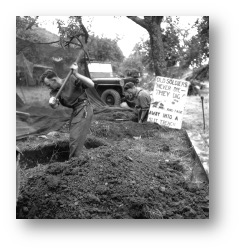
Left: “Old soldiers never die – They dig and fade away into a slit trench” Two Canadian soldiers of the 2nd Canadian Armoured Brigade dig defensive slit trenches shortly after their arrival during the Invasion of Normandy. 25 July 1944 in WW II.
From: https://imgur.com/5v4RBz9
Right: Going over the top – Battle of Vimy Ridge in WW I.
Lakecountryrotary.ca
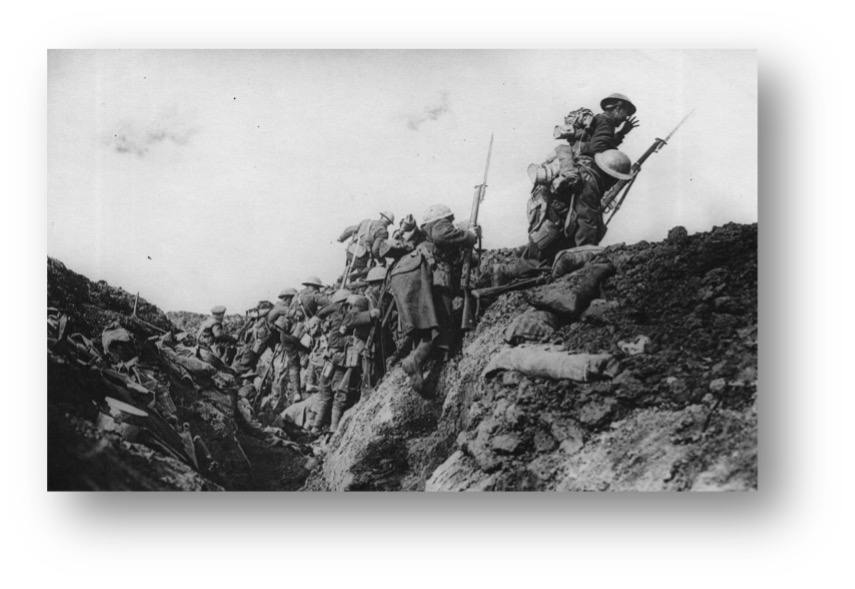
North Gwillimbury 1885
The following was excerpted from: The History of the County of York, Volumes 1 by C. Blackett Robinson Publisher 1885 pp. 166-169.
The early records of the township show, that in 1821, the number of the inhabitants of North Gwillimbury and Georgina were 272. In 1822 the population of the two townships had increased to 314 in 1823 it was 339. North Gwillimbury, in 1842, contained 697 inhabitants in 1850 the number was 1,172. The census of 1871 showed a population of 2,304, which, as in most of the townships, has fallen off somewhat during the last decade, the census of 1881 giving the number as 2,151. Of this number 1,869 are of Canadian birth.
The agricultural products of 1849 included 26,000 bushels of wheat, 13,000 bushels of oats, 5,000 bushels of peas, 13,000 bushels of potatoes, and 10,000 bushels of turnips. In 1881 the yield amounted to 53,168 bushels of wheat, 22,921 bushels of barley, 76,720 bushels of oats, 20,843 bushels of peas and beans, 24,367 bushels of potatoes, 26,833 bushels of turnips, and 2,692 tons of hay.
The occupiers of land number 335, of whom 224 own the soil, the total area in occupation being 28,783 acres, of which 19,106 acres are improved land. The area devoted to field crops is 14,763 acres, 3,826 acres being pasture, and 517 gardens and orchards.
The townships of North Gwillimbury and Georgina were united for some time. The officials for the united townships for 1822 were as follows: Arad Smalley, town clerk; Holland A. Payson and Alexander Lawson, assessors; Joshua Utler, collector; Erastus Smalley, Asa Crittenden, George Williams, Daniel Mann, Zenas Hentley, Fountain D. Hunter, and William Carter, path-masters ; Silas Ernes and L. Hale, pound-keepers; William Crittenden and Joseph Lile, town wardens. In 1823 Arad Smalley was town clerk; Asa Smalley and Benjamin Jefferson, assessors H. H. Payson, collector, and Joel Draper and Simeon Martin, town wardens. The town wardens for 1824 were Jacob Draper and J. Donald for 1825, John Comer and Squire Martin. In 1826 the Township of Georgina was separated from North Gwillimbury, and the record of municipal proceedings thenceforward relates to the latter township only.
In 1827 Joel Draper and David Mann were town wardens; Silas Ernes, assessor; John Prossor, collector, and Arad Smalley, town clerk. In 1828 David Sprague became township clerk, an office which he retained until 1842. James Crittenden and Ephraim W. Payson were town wardens for the former year. The town wardens for some years following were as follows: 1829 David Sprague and Noah Gager ; 1830 Joseph Rose and Martin Warmer ; 1831 J. Rose and Squire Martin; 1832 Abraham Sedore and Austin Huntley ; 1833 N. Gager and Joel Draper; 1834 Silas Ernes and Israel Bennett ; 1835 J. Ross and E. Willoughby.
In 1836 the municipal system underwent some changes. D. Sprague, B. W. Smith, John Prossor and Justin Hatfield were chosen commissioners. In 1837 the commissioners were Justin Hatfield, Isaac Bennett and Peter Bilder. A memorandum dated 1st of January, 1838, is as follows: In consequence of the Rebellion which broke out on the 4th of last December no township meeting took place this day. The township officers of last year therefore remain in their various offices during the year. David Sprague, town clerk. The records contain a minute of a special session of the magistrates for the division of North Gwillimbury and Georgina, held at North Gwillimbury on the i6th April, 1838, bearing the signatures of Arad Smalley, J.P., and Thomas Mossington, J.P. In 1839 Oliver Barton, N. Gager, and D. Sprague, senior, were town wardens. There was another special session of magistrates of the two townships this year at which Arad Smalley, James D. Boucher, of Georgina, Thomas Mossington, and Simon Lee were present. In 1840 the town wardens were Silas Ernes, J. Bennett, and G. D. Earl; in 1841, D. Sprague, sen r, and George D. Earl; 1842, J. Carbett, Silas Ernes, and George W. Chipperfield. In this year David Dawson was appointed town clerk in place of Mr. Sprague, and retained the position until his death, in 1846, when Mr. Sprague was again chosen to the office. The town wardens for 1843 were G. D. Earl, G. Chipperfield, and J. Bennett. In 1844 the Home District Council was organized, Isaac Bennett being chosen councilman for the township. The town wardens for this year were, G. W. Chipperfield, N. Gager, and D. Sprague, sen r. The town wardens for the remaining years during which this office existed were as follows: 1845 H. Huntly, Austin Huntly, Simeon Huntly : 1846 T. Mossington, Israel Shepherd, J. Chipperfield ; 1847 Cornelius Silver, William L. T. Corbett, G. D. Earl; 1848 John Prossor, Hugh H. Wilson, Silas Ernes; 1849 Nicholas Bennett, Robert Anderson, S. Sprague, sen r.
In 1850 it is recorded that the first meeting of the municipal council of the township took place on the 22nd of January, at Dughill school house, Isaac Bennett being reeve, and Messrs. J. Prossor, Arad Shepherd, J. Morton, and D. Sprague, councillors, and Richard Sheppard, township clerk. Thomas Mossington became reeve the following year. In 1852John Prosser was elected to the reeveship. He was succeeded in 1853 by David Sprague, who held the office for two years. He subsequently held the same position in 1856, 1858, and 1864. In 1855 and 1862 the reeveship fell to John Morton and in 1857 to D. B. Wilson. Thomas Evans filled the chair in 1859 and again in 1861, William Henry in 1860 and 1865, Henry Draper in 1863 and subsequently for the period 1866-69. In 1870 he was succeeded by John Marritt who had a five years term, and filled the position again in 1876. Elijah Prossor and Willard Bennett are also among those who have held the office of late years. The present reeve is R. M. Van Norman of Keswick, the deputy-reeve being D. H. Sprague of the same place. The other councillors are Stephen Winch and J. D. David son, both of Belhaven, and John Boag, of Ravenshoe. Henry Sennett, Belhaven, is township clerk; E. Nosser, of Keswick, treasurer, and Ellis Sheppard, of Belhaven, assessor.
The township meetings, for some fifteen years past, have been held at Belhaven, a village containing about a hundred inhabitants, occupying a central position in the township. Keswick, originally called Medina, is picturesquely located on the summit of the uplands, overlooking Cooke’s Bay to the west. The population is about one hundred and sixty. Three miles to the north is the village of Roach s Point, on the headland which forms the northern limit of Cooke s Bay, the romantic situation and surroundings of which have not availed to induce its growth. It was formerly known as Keswick, but lost its official designation when the post-office was removed to the lower village. A mile and a half south of Keswick is Jersey. The three villages are connected by a road following the course of the elevated land along the coast. Another road* strikes across the town ship in a north-easterly direction from Ravenshoe in East Gwillimbury.
This was the outlet of travel to Yonge Street in the early days of settlement. The Lake Simcoe Junction Railway traverses the township from south to north within a very short distance of its eastern boundary.
North Gwillimbury contains seven school sections, and seven teachers.
No. 1 is half a mile east of Queen Street, and on the first side-road north from the town-line south. It is a plank or frame building of considerable age, and not so comfortable as recent improvements have made pretty general. The average attendance under the present teacher, Miss Sarah Earl, is 35.
No. 2 is also on Queen Street, five miles north of the town-line, and half a mile north of Keswick, or Dug Hill. The house is a rough-cast frame of good size and comfort. The average attendance is 33. Teacher, J. E. Pollock.
No. 3 is situated on the base-line, two miles directly west of Sutton, and one and a half from Lake Simcoe. The house is an old plank or frame, with some recent improvements and good furniture. The average attendance is 32. The teacher, Miss T. Price.
No. 4 is nearly in the centre of the township, on the farm of JohnMorton, Esq., lot 18, 5th concession, and is an old frame house fairly furnished and kept. Average attendance, 41. Teacher, Miss Sarah Fisher.
No. 5 is on the south-east corner of lot 6 in the 5th concession in the English Settlement. It is an old frame building, with a recent addition to make legal space for the school population, but not comfortable or attractive inside. Miss Thusnelda Borugasser is the teacher. Her average attendance is 40.
No. 6, or Roach s Point School, is an old frame house on the base-line, about six miles west from Sutton, on lot 23, 3rd concession. The average attendance under the present teacher, Miss Jennie Rogers, is 20.
No. 7, known as Gum Swamp School, is situated on lot 15, 7th concession. The building is a neat and comfortable frame building erected in 1882. Miss Mossie Sheppard is the teacher. The average attendance is 18
Pioneer Ancestors
The following biographical sketch was excerpted from the Georgina Township section of The History of the County of York, Volume 2, by C. Blackett Robinson Publisher in 1885, p. 511.
EZRA SHERWOOD, lot 13, concession 5, was born in the Township of
North Gwillimbury in the year 1817, being the son of Thomas and Annie
(Mitchell) Sherwood. His maternal grandfather was the second settler in
North Gwillimbury. When our subject was a boy they had to carry their
grain to mill at Sutton, and he remembered when there was only one house
in Sutton, besides the store. His grandfather assisted to make the first
mill in that village, and came very near losing his life at the time.
Where in Georgina?
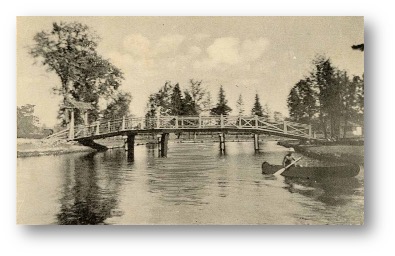
No-one has guessed our mystery location yet; where in Georgina was the image to the left located?
News
Your society will be issuing a limited edition 2022 calendar as a fund raiser featuring scenes from the Pioneer Village. As only 150 copies will be printed, be sure to get your copy early; contact Tom Glover. They will be available the same as last year for $15 each.
With the changes to the COVID rules we may be able to resume our regular meetings. We will confirm this with more information regarding the places and times for our meetings in the Events section of our newsletters. If we are able to resume meetings in January, our first meeting will be a “Bring and Brag” session. Stay tuned!
Our Annual General Meeting will be held on November 18th at 7:00 PM in the De La Salle Hall. At the AGM, the positions of Vice President, treasurer, and directors will be elected by members present from a slate of nominations presented by the Board of Directors and resulting from a request for interested parties and nominations. Owing to COVID complications we will forego the annual dinner and provide coffee and snacks instead. The meeting itself will consist of a business section and our annual elections followed by a visual presentation updating the progress in the Pioneer Village. Memberships are due for 2022 and may be renewed at the meeting. Membership cost is $20.00 per member.
Events
Thursday, November 11th – Remembrance Day
Thursday, November 18th – Annual General Meeting at 7:00 PM, De LaSalle Hall
First Saturday in December (December 6) – Sutton Santa Claus Parade
Month of December – “Festival of Lights” along the Parkway between the Village and the ROC
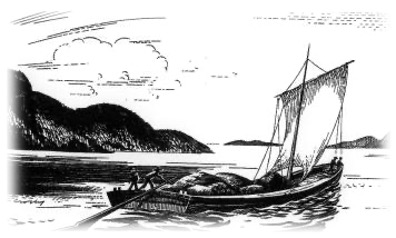
A Durham Boat
